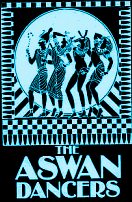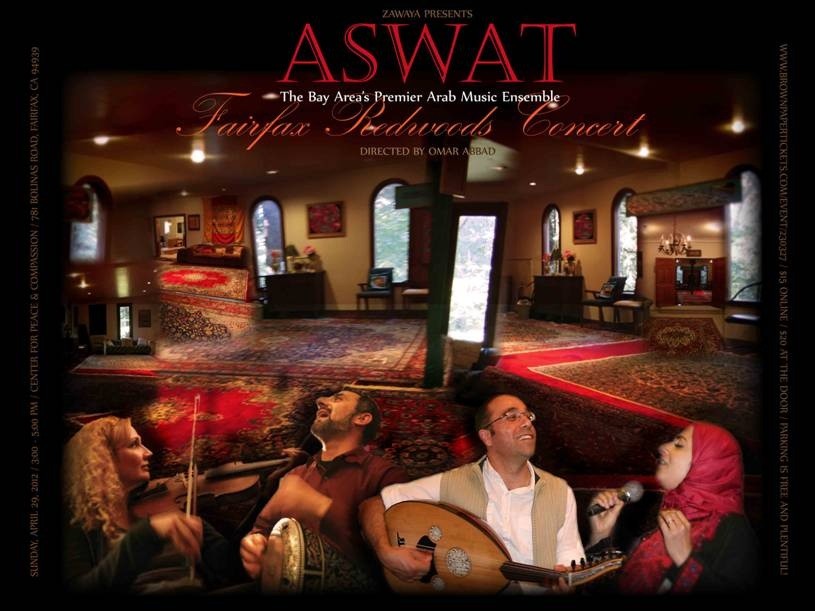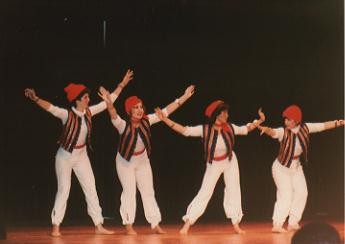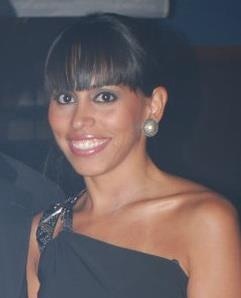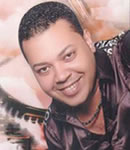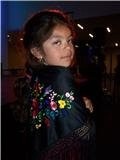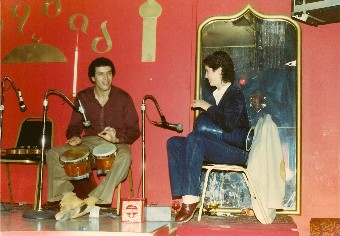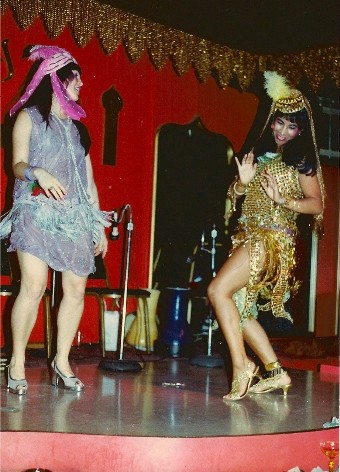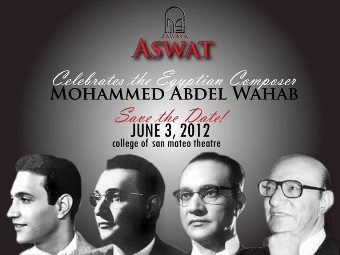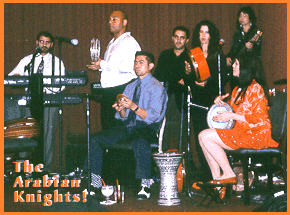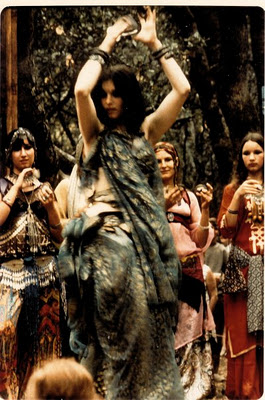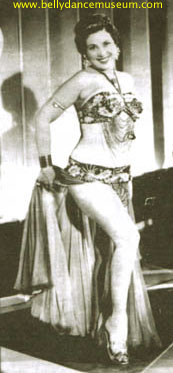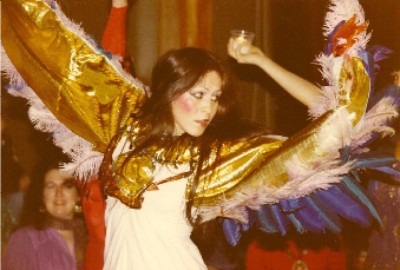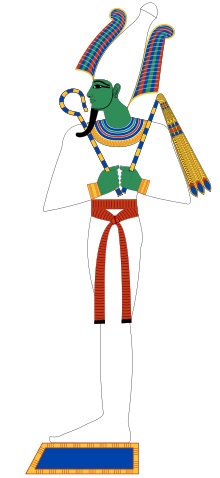Ba Olek Eh - Amina's Daily Blog
(tell you what)
April 30 2012
Monday
Drumming
Al Masri was fun last night. It was Mohamed
Amin's live music night. Husain sang and played the violin
and I played the drum along with the drum machine on Mohamed's keyboard.
I guess I'm supposed to fool the people into believing that I'm really
playing the drum. Well, I guess I am, but I don't have to carry the show
since the drum machine is doing that. It's kind of an interesting way
to practice my riffs and also my speed. There's absolutely no pressure
to play everything and I can experiment with different drum techniques.
Tonight in drum class I found a nice song with masmudi, maqsum and chifte
telli and after our drills we spent the rest of the class playing along
with the CD experimenting on different ways to play those three rhythms.
It feels good to play along with a CD because even if we mess up, the
drummer on the CD keeps going and makes us sound good. But the best thing
is that with a base drummer holding down the rhythm it really allows us
to experiment and be creative. This is a special treat at the end of class.
It makes us feel that our drills are starting to pay off and we can actually
play and be musical.
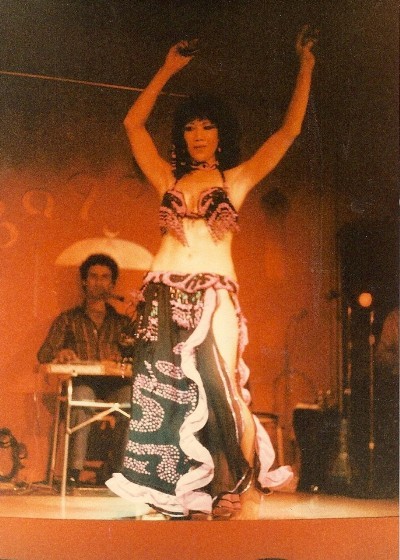 Mohamed
& Shamira at The Bagdad 1983
Mohamed
& Shamira at The Bagdad 1983
At Al Masri I also experience that feeling of being creative. Sometimes
when Mohamed or Husain are playing a taqsim, Mohamed doesn't use the drum
machine so I am free to play the slow section with a chifte telli, wahedeh,
sombati, rumba or bolero. When they change into the next section I continue
playing the drum machine starts. Sometimes it doesn't start until the
end of the next song and I hope that means that I'm doing OK. That's ok
with me, but it usually feels too quiet without backup drummers and I
welcome the drum machine when it clicks back on. Also I don't feel adventurous
enough to play all the subtle variations to make the percussion section
sound professional. I like hiding behind the drum machine. Maybe someday
I won't, and will want to be the main drummer, but I don't think that
will be in this lifetime.
April 29 2012
Sunday
Aswat in the redwoods
Today we had a concert in Fairfax in Marin county at the
Center for Peace and Compassion. We had no idea what to expect,
except that we were told that we would be playing without shoes.
They've been working on the approach to the Golden Gate Bridge for
over a year and this weekend, to speed up the process, it was announced
that the main approach would be completely closed. It was advised that
the best and fastest way to go to Marin from San Francisco, would be to
travel east over the Bay Bridge, then north to Richmond and then
west over the Richmond Bridge and then south to whatever Marin
destination. Yes, the best and fastest way would be at least an hour or
more.
We decided to carpool it and take our chances with the single bridge approach
left open to a predicted tremendous parking lot type traffic jam. We were
allowing ourselves a good two hours for what would normally take 30-40
minutes. About 1/2 an hour after we left, we arrived in the town of Fairfax.
The bridge and the highways were empty. So we decided to stop for coffee
and snacks. But we were in Marin and every thing was healthy, vegan, organic
and natural. After having a very overpriced gluten free, cardboard tasting
not very sweet, sweet roll, we left in search of a fast food outlet. We
needed a familiar taste. We were in luck. There's still hope for Marin
county. We found a Seven Eleven that sold snacks and drinks that were
recognizable. Yes, let's hear it for a turquoise blue brain freezing icee.
Slurp.
We really were in the country. Marin is the country. The winding hilly
road had trees and was barely wide enough for the car and the 20 guys
riding bicycles 3 bikes wide. I was afraid to pass them because there
wasn't enough room for another car or visibility for a passing lane. But
finally nestled in the shrubs and trees we found a small sign that said
Peace and Compassion. We turned off the main road and started winding
up through the redwoods. We saw a rustic looking little shed-like cabin
with a crude hand painted sign that said "mosque". Huh? This
is a mosque? Chakib who was riding with us said, "Mosque?
I'm not playing in a mosque. It's against my religion." We decided
that there must be another building, but also remembered that we were
told we would be playing without shoes. Don't they take shoes off in a
mosque?
After a bit we found a flat clearing and a few familiar faces. So there
was another building and it wasn't a mosque. Good! We entered this building
and had to take off our shoes because it was piled with beautiful Oriental
rugs and the clearing in front of the building was barely paved. Well,
it was paved with gravel and redwood needles. Yes, indeed we were going
to play with no shoes on and our audience was going to sit at our feet
cross-legged. Only in California? No, "only in Marin".
While we were rehearsing, a barefooted little old man garbed in a long
brown, robe swathed in various lengths of soft fabrics covering his robe
and his head introduced himself. He was the imam and he started speaking
of peace and spirituality. Nabila allowed him say about three sentences
and then told him he had to leave because we were rehearsing. Only Nabila
could do something like that. He left.
I don't know where all the people came from but they came. Outside of
a few friends who were coerced and bribed to see us, we actually filled
the place. I really don't know where they came from, but they came. This
place is not that easy to find. The interesting thing is that most of
our audience was not from the Middle East. Where did they come from? Why
did they come? This was Marin and we certainly weren't the Grateful
Dead. Maybe it's only important that they came.
Later some of the Aswat group strolled around enjoying the grounds
and they swore they smelled that familiar weedy smell found "only
in Marin".
Oh yeah. I think we played pretty good. At least the audience seemed to
like us. Only in Marin? Hopefully other places too!Home
April 28 2012
Saturday
Waiting for Eleanor
After class, Judi and Kathy came by. We
sat in the dance studio waiting for Eleanor. Eleanor used to be
an Aswan Dancer until she moved to Ohio. She moved to Ohio
when her son Ben was a baby. He's in college now and Eleanor was
in the Bay Area for her high school reunion.
The three of us, Kathy, Judi and I had a nice visit while waiting for
Eleanor, but she never showed. Well, we never actually communicated that
we would be waiting. She had sent us all a note that she would be in San
Francisco - arriving Friday night, reunion Saturday night and leaving
Sunday morning and we just assumed that she might drop by. I forgot to
write back to make definite plans with her and I think that Kathy and
Judi just assumed she'd stop by because she knows my class schedule and
when she's in town, she usually just drops in after class or during a
rehearsal.
The rhythm was probably wrong because she usually would come on a Tuesday
night, timing it for the end of a rehearsal. When she used to live here
we had a Tuesday night ritual. Rehearsal would end and we all would continue
on down the street to Haystack Pizza. We all were usually Judi,
Gregangelo, Eleanor, me and sometimes Anke. We would always order
the same thing - the house salad with extra beans, bleu cheese and thousand
island dressing on the side, one plate of steamed vegetables to share,
hot water, no tea and Eleanor would also order a glass of wine.
Susu, Teri, Eleanor and MaryAnn 1979
Aswan Dancers dance to Mohamed Al Bakar's Port Said
When Eleanor was single she answered a few ads - this was before computer
dating - and we would sometimes read them and help her decide who to date.
It was part of our Tuesday night ritual and reading the replies to the
ads was great entertainment. She was looking to find a husband, but we
weren't helping her. None of our choices seemed to be any good. Then one
weekend she went to a party and met her roommate's brother. Marriage was
soon on the horizon.Home
April 27 2012
Friday
Transferring music
Lately I've been feeling overwhelmed by the amount of
media that I've decided needs to be transferred, but then I realize that
it's not the media that is overwhelming me, it's really the space that
the old media - the cassettes and the LPs - take up. I think that I really
need to at least go through all my old transferred cassettes and decide
which ones I really want to keep for back-up and why. I know it's because
I really don't trust the newer media. But if I'm not likely to use a certain
CD that much, shouldn't that be an indicator that the original cassette
won't ever be needed. That's great, a new chore - having to decide what
to dump. Even though I wasn't a child of the Great Depression, I guess
I was a child of a third world and it's painful to just throw out something
good.
I wish Marcela still
lived here. She had a cassette player in her car so I felt ok about giving
her my old cassettes. I suppose I will just start asking people if they
still use cassettes. But that will be after I am ready to let go. I guess
I need to give myself a deadline. Maybe this will be a couple of months
from now for the first batch of cassettes. I'll just keep reminding myself
of how much room I'll have when I do this.Home
April 26 2012
Thursday
Gold Plated Cymbals
Many years ago I was given a set of gold plated cymbals
by Ali Hamidzadeh
of Turquoise International. Turquoise is known for costumes - they
were just about the first U.S. vendors of Egyptian design costumes, but
they also manufacture the best cymbals. Ali the owner who lived in southern
California, was an engineer, tour leader, workshop sponsor, costume importer
and the creator of the greatest sounding dance cymbals.
One night Ali came into the Bagdad and said that he had just perfected
a technique for gold plating his cymbals. He gave me a set and wanted
me to try them out. Well, what could I say? I had been using expensive
Zildjians and Naz Minassian cymbals from Boston and here was
Ali offering me free cymbals. I already had been offering Ali's cymbals
to my students because they sounded good and now I had the opportunity
to "test play" gold plated ones and compare them to the professional
cymbals offered by Naz Minassian and Zildjian. They turned out to be my
favorite cymbals and not only surpassed the sounds of my other cymbals,
but also they didn't break, crack or bend.
In 2005 Hurricane Katrina hit New Orleans and completely devastated
the city. Fortunately my friend Betty Karam, a dance teacher in
New Orleans, was visiting her daughter in Oregon when the hurricane hit
New Orleans. Besides the fact that Betty and her husband Jim couldn't
return home and that her husband's job was greatly compromised by the
flood, she seemed to accept having to live in Oregon temporarily because
she could extend her visit with her daughter.
We had many conversations wondering about the welfare of her friends,
the state of her home and her belongings. She kept telling me that she
hoped her gold plated cymbals were ok. When she finally went back to New
Orleans to see what disasters were waiting for her at home, she immediately
called me and told me that she was so happy that her cymbals had survived
without a scratch. Never mind that the city was in ruins, her husband
couldn't immediately go back to work, some of her friends were homeless,
her house was a mess and life was not as it should have been...the important
thing was that her gold plated cymbals were still there and as good as
new.
Sometimes I give private cymbal lessons and I had recommended that my
student buy better cymbals. I recommended Turquoise brand. She listened
and in fact she bought a couple of sets of Turquoise cymbals. One set
turned out to be too large for her use so, upon hearing them, I thought
the best solution for her would be for me to buy the large ones from her
so I could add to my collection of good sounding cymbals. They are too
large for regular performances but are perfect for teaching.
They're great sounding, but they're not the same as my gold plated ones
that always reside in my purse. Almost, but not the same. I was one of
the chosen few - hurray! - who got the golden cymbals with the golden
sound. Unfortunately for the rest of the world, Ali chose not to manufacture
gold plated cymbals because they were too expensive to make. Home
April 25, 2012
Wednesday
Terrorism and kababs
Today's big news is that Adel Imam, Egypt's popular
and well respected film star of romantic, dramatic and comedy roles was
sentenced to 3 months in prison and one thousand Egyptian pounds (about
$170 U.S.) for appearing in 3 movies. "Erhab wel Kabab"
Terrorism and Kabab, "El Erhab" The Terrorist and "Morgan
Ahmed Morgan". "Morgan Ahmed Morgan" was released in
2007 and is about a corrupt businessman.
I remember "Terrorism and Kabab" (1992) very well as I believe
I saw it at a local movie theater here during some sort of film festival.
Because I also have Satellite Dish Arabic channels, I later saw it on
the television. It is a satire of Egypt's bureaucratic system. In the
story a worker acccidentally takes a major government building and its
occupants hostage. His demands are for take-out food. It's just another
sympatic hostage movie gone sour.
In "The Terrorist"(1994), Adel Imam plays a militant Islamic
terrorist who is befriended by a Coptic Christian family. In 2001 I was
part of a band called The Arabian Knights and we used to rehearse
in my studio every Wednesday night. After 9/11 we still continued to rehearse
on Wednesdays, but the other band members, all Arabs, were kind of preoccupied
and nervous...kind of jumpy. About a week or two after the 9/11 event,
we had a power outage in my neighborhood and when my studio went completely
black with no hint of any light and the band absolutely freaked. I was
the only non-Arab in the band and the only female and all the nurturing
instincts took over, so after the electricity came back on and they calmed
down a bit, I brought them upstairs (studio is in the first floor of my
house), gave them something to eat and drink and suggested we watch a
little Satellite Dish. Maybe we could find a game show with singing and
dancing to calm the nerves. Instead, there was an Adel Imam movie on.
Great! He's fun and funny. So we started watching. It was "The Terrorist".
It was funny, but the boys didn't really enjoy it - at least not that
night. "No, I'm not a terrorist." "Not, all Arabs are like
that." Finally I just turned off the TV and had to reassure them
that, no I didn't believe they were terrorists. Musicians? Terrorists?
I don't think so!
So on the way to Aswat I told Husain about Adel Imam getting convicted
for insulting Islam. Adel Imam is one of Husain's favorite actors. Well,
he didn't really want to hear about it. I only told him because I wanted
to know if it was true as I can only read English print news. He hadn't
heard about this but he also didn't want to. We spent the entire time
on the bridge with Husain telling me sweet innocent cartoon like jokes
about "Tom and Jerry" and "Mickey Mouse".
I kind of felt bad. Maybe this news was too close to home. Home
April 24, 2012
Tuesday
The devil said to the slave
Went to Costco to buy blank music CDs and what
I'd been dreading has become a reality. No more bulk music CDs, only regular
media CDs and they don't work with my recorder. Thank god for Amazon.
I ordered some and they should be here in a couple of days. I heard that
they are obsoleting CDs and by next year music will be in the clouds?
I don't like this. I really do belong to the last century - certainly
not this one. I also like sound systems with knobs and I despise remotes.
I know I will have to change my thinking soon. But, I'll hold out as long
as I can. In the meantime, I guess I'll just keep buying blank music CDs
in bulk as long as I can find them. Hopefully if there's a buyer, someone
will continue to manufacture them.
I have been transferring Ayman's cassettes to CD and today he told
me that soon he'll just put all his music on his computer so I shouldn't
even bother to make him a copy of the CD. That will save me some CDs and
time, since instead of making two copies - one for him and one for me
- I'll just make one copy for him to transfer and then he'll return the
CD to me.
Now my dilemma is: what do I do with the master copies, the cassettes?
I think I will keep the most important ones for back-up and then give
the rest away. Now I just need to decide what really is important because
I tend to think everything is. I need a hatchet man.
Mahmoud el Husseiny
I brought a Shaabi song to work on with Ayman. It is pretty long so we
only worked on half the song. I chose the song which is by Mahmoud
el Husseiny because it is of the DJ Sufi/Mulid genre and it provides
me with lots of words that are not usually found in Egyptian tarab or
pop songs. It is full of "street talk". I don't know the name
of the song, but it is like
el abed walshytan which is probably one of biggest hits.
Mahmoud el Leithy
Although he seems to be friends with Saad al Soghayar and Mahmoud
el Leithy, each of the three friends seem to have carved different
niches in the recording/mulid/wedding world. While all three have also
entered the film industry, it seems that only Saad has continued on to
star and act in movies.
Saad, who seems to have started the "dancing boys" craze with
wild, fun high energy 5 star hotel party entertainment with lots of synchronized
drumming and dancing might even be thought of as crossing over and going
beyond the Shaabi scene.
The two Mahmouds - el Leithy and el Husseiny, on the other hand seem to
have cornered the market in the local sufi/mulid scene and the Shaabi
style weddings. El Leithy appears to prefer singing more peaceful and
sufi love songs and el Husseiny seems to go for the controversial such
as "el abed wal shitaan" the slave and the devil and songs of
revenge like the song Ayman and I are working on. They are preaching repentance
but are not quite as controversial as Shabaan al Rehim's songs. They are
pretty outspoken, nevertheless.
al shaytaan ‘al al abed
The devil said to the slave
metnefed wethalis methartil wetefis
metnefed -dust you off wethalis – mess around
law ayez tetnemerad Tab m anta keda kwais
tetnemerad–bite the hand that feeds you
If I want, I’ll bite the hand that feeds you, you’re doing OK,
why do you want to do that.
Tab manta keda kwais
you’re doing OK, why do you want to do that.
Tab manta keda kwais
you’re doing OK, why do you want to do that.
ma tula we tebshish ama anta ibn lizeina
lizeina, literally - there you have
like you’re going up, you son of a bitch
we matwala we hashish we la aHna fee banzina
Why don’t you light up, roll some hashish and smoke, what are you
a gas station?
al abed ‘al shaytaan
The slave said to the devil
haseebak almaSee we aSwan rasul allah
aSwan-pl. prayers
I will leave you with the and prayers of the prophet of god
we an geity habaadak baaayat kitab allah
If you came to me I will make you go away-from the psalm of the book of
god
we madam haraga aSlee mash hetaref tuSly
And the more you do it (continue) I will return to my roots
and you won’t be able to find a way to get to me.
wel nas b’ee tetalem min kul illi Hasaly min kul illi HaSaly
And the people can learn from all that happened to me
min kul illi HaSaly
from all that happened to me Home
April 23 2012
Monday
Bahlem Beek
Tonight Marilyn brought in some music to play in
class. It was "Bahlem
Beek". This is a song from the movie "Hekayet
Hob" The Story of Love, (1959) starring Abdel Halim Hafez.
The words of the song are by Morsi Gamil Aziz. "I dream of
you, I dream of you and with my longing I await you. And if you check
up on me it would be enough for me. I lived happy nights dreaming of you.
I dream of you."
This brings back many memories. In the late 1960's to the early 1970's
once a month, Samir Khoury of Samiramis would show an Arabic
movie in a rented movie theater. This was such a treat! There was no other
way to have any film connection with the Middle East. There was other
opportunity to see Arabic dancing - to see what the "real thing"
looked like from "back home".
This was during the time when music was only available on records or possibly
on a giant teac 1/2" reel to reel tape recorder if we knew
any people who brought music back from the Middle East. Video was not
available or maybe not invented yet. At least it was not available on
the consumer level.
So, once a month, what seemed like the entire Bay Area Arabic community,
men, women and children, including crying babies, would bombard the Avenue
Movie Theater on a weeknight to see a movie. It was a picnic. It was
a family reunion and it was a chance for way less than a handful of American
dancers to hope to maybe see almost 3 minutes of a dance scene in a movie
that had no subtitles. I was one of the dancers who would hope. And sometimes
leave disappointed. Not all the movies had dancing. But there was always
an abundance of noise and food - as in babies and children crying and
having food fights with their "bag lunches". But, upon reflection,
it was all worth it. Even on the nights when we didn't get to see or hear
music or dancing, we certainly got a great exposure to Middle Eastern
culture.
Occasionally we were treated to a great movie. "Hekayet Hob"
was one of them. When we heard that there was an Abdel Halim or a Farid
movie, we were sure to line up way in advance knowing that for sure we'd
hear music and quite possibly see a bit of dancing. Abdel Halim's movies
didn't always have dancing but for sure Farid's would. We soon discovered
that these two stars would act in almost autobiographical stories. Abdel
Halim (who came from a humble background) usually played the role of a
poor singer who fell in love with someone from a higher class - a love
story doomed before it even began. Farid (who in real life, had heart
problems) many times starred in movies where he was sick or would "die"
of a broken heart. Both stars were quite adept in playing the tragic heroes
and we all loved these movies.
I don't remember any dancing in "Hekayet Hob", but I sure do
remember getting completely involved in the tragic melodrama of the story.
And I do remember loving the film so much that the next day, I ran to
Samiramis to buy the soundtrack. As I wore out the grooves on the record
I would be treated to reading the words of the songs and in English! This
one was of the first records that had English translations printed on
the cover. Believe me this record was a goldmine of information and memories
during the time when so little information was available.
So tonight, when Marilyn brought in her belly dance version of "Bahlem
Beek", I insisted on also playing the original. And as we danced
to it, I remembered Abdel Halim in the movie. What can I say? Bahlem Beek
is one of my favorite songs - along with about a hundred others.
bahlem - I dream (yesterday, today and tomorrow)
ana - I
kefaaya - enough
layali - my nights, i=my
haneya - my happy, tenderness, i=my
awel - first
akher - last
enta - you, m. enti=you, f.
hayati - my life, i=my
ebtrisaamati - smile, i=my
nur - light
ain - eye
alb - heart
gana - heaven, garden Home
April 22 2012
Sunday
Raqs Nawa'em
We got to Aswat a little late today. It was my
fault. I was so busy listening to music and playing with my LPs that time
got away from me.
I have a huge project transferring music from flash drives and cassettes
to CD and now I want to transfer LPs to CD. Fortunately I enjoy doing
this.
In particular Susu wants me to copy a drum solo from an LP album produced
by George Elias of the Bagdad called "Nawa'em".
He had contracted Lebanon's Aboud Abdel Al and his Golden Strings
to record the album with him.
"Nawa'em" is a very classic LP featuring a drum solo that
Susu likes to call SADS. SADS is Susu's acronym for what she's coined
Standard Arabic Drum Solo. The intro song, "Nawa'em" is beautiful
and includes an extremely beautiful and long chifte telli taqsim that
I consider old school. Most magensies don't include such beautiful taqsim
solos and drumming like this anymore. It is very reminiscent of what I
like to call the first Arabic magensi ever, "Raqs Hawanem".
In "Raqs Hawanem" there, too, are the chifte telli taqsims.
In fact, all the old magensies included them. I don't know why they stopped.
It possibly could be because it brought back memories of the Turkish influence
and Egypt was leaving those memories behind. I really don't know, but
I do think it had to do with removing some of the Turkish influences and
inviting the European ala Abdel Wahab.
"Raqs Hawanem" is a musical that was used during the time of
Badia Masabni. It was pre Nasser and the music was starting
to be very cosmopolitan. Still slightly Turkish in sound, but also sophisticated
European. "Raqs Hawanem" was also known as "The
Ladies' Dance". The name and the music implied that "Ladies"
of upper Westernized social classes danced to it. In the album,
Nawa'em and within the musical "Raqs Hawanem" are fantastic
taqsims (pl. taqasim) with some wonderful drumming. I guess I will
turn this wonderful record into a CD so I can use it in class. If Susu
is resurrecting classic drum solos, well for sure I should at least resurrect
classy music like "Nawa'em" and the "Ladies' Dance".
And then we can all be "Ladies" of a certain social class ever
so slightly merging the old with the new and the East with the West.
Home
April 21 2012
Saturday
Luara
Laura and Luara came to class today. So
did Asima and Aisha.
They're mothers and daughters. Aisha who is Asima's daughter, is in high
school and they've been studying we me for about a year and a half. Luara,
is Laura's daughter and today was her first official lesson. Laura has
danced with me off and on for over twenty years and Luara has benefitted
by dancing with her mom at home. She's pretty good. Also Luara has hung
around my studio quite often for her past eight years and a half years
and Arabic dance is just a part of her life; just like speaking English,
Spanish and Portuguese is.
It's so amazing to see and hear how she naturally knows what language
to speak. With her dad she speaks Portuguese and with her mom, she speaks
Spanish. I also speak Spanish to her, but she will answer me in English.
She just knows. I guess my accent must be pretty bad. I hope it's not
the grammar.
In class today I was translating a few songs saying the Arabic word and
then supplying the English meaning. Later, after class, when Laura and
I were talking, Luara asked me to remind her again about a couple of Arabic
words. If she continues to come to class, I predict that she'll be speaking
Arabic soon. It's not fair. And I bet someday, if I speak to her in Arabic
that she'll reply in English.Home
April 20 2012
Friday
LPs
Susu stopped by today to talk about her plans for
her drum class and a few planned workshops. We talked about making a study
CD with various drum solos and got us discussing various favorite drummers.
One time when I was in Egypt I told Hasan Ali, the drum maker that
I wanted to meet Negm Nabil who was a famous drummer. Just like
that, he took me to meet him in Giza at his music studio. When I met Negm,
I told him that Susu and Faisal sent him hellos (Susu and Faisal
did not know him) and he gave me a CD of his drumming to give to them.
Negm Nabil is old school as are Said el Artiste, Khamis Henkish, Setrak
Sarkisian and a few others.
It's going to be pretty exciting making to this study CD because Susu
wants me to go through my old LPs and copy some of the drum solos. Since
she learned her drumming and technique listening to and playing along
with these LPs, this makes perfect sense. I pulled out the LPs on the
list and started listening to what she selected. There may be many great
current drummers with interesting and exciting drum solos, but these old
school drummers really defined what a drum solo should be and how it should
sound.
This project will not only be fun but it also will be a learning experience
for me. When Susu mentioned the LPs, my laziness was wishing that the
solos were on CD. But they're not and when looking at my LPs I realized
how many great pieces are only on these LPs. It's like rediscovering new
music.
I can hardly wait until we start making up the lesson plans based on these
LPs and these great drummers.
Fortunately these drummers are still around and have some of their compositions
on CD, but some of their best stuff is only available on LP records. Lucky
for me I never throw anything away, so of course I still have the LPs
and Susu will have her study CD. Home
April 19, 2012
Thursday
Cymbals as a musical instrument.
When I teach drum we drill and work on tones and various
different patterns. Some patterns are actual rhythms and some are just
coordination exercises. Tonight we worked on the cymbals the same way.
Usually when I teach cymbals, I teach a rhythm such as beledi RR rlr R
rlr rl and leave it at that. Tonight I decided to work on the tones -
the rings, the clacks - the clicks, along with some exercises to strengthen
the coordination. We also worked on a couple of songs going back and forth
from playing a rhythm like beledy and just playing riffs for ornamentation.
It was kind of fun. I hope the class enjoyed it too because I am going
to keep it up for a few weeks.
I really don't know how to treat playing cymbals in class. For the most
part, dancers don't use them while dancing. They especially don't use
them when doing Egyptian style belly dance as it isn't done over there.
Since it can seem to be out of place and totally unnecessary for an Egyptian
dancer, a lot of dancers can't play them very well. However, it's weird
to see a really good dancer who is a total klutz when it comes to performing
with cymbals. Having to play them, such as by request, can be embarrassing
if the cymbal expertise doesn't match the dancing.
And, since this is America, anything and everything goes. So we should
be really adept at playing cymbals. We should be able to play them so
well that the cymbal playing enhances the dance.
I'm not saying that we need to play cymbals in all our performances or
even in part of a performance, but we should be able to make it a choice.
Playing cymbals in a question/answer form within a drum solo can be quite
entertaining. Also playing cymbals during a Saidi piece can be very effective.
Other times that cymbal playing is nice is during a special folkloric
piece, a cute dellae type dance or when dancing around the audience for
audience participation or while "collecting tips".
Of course in Egypt the tura, cymbal player is part of the band, but here
we don't usually have the luxury of another band member playing cymbals,
so it is often nice to here the cymbals during parts of a dance. We just
need to remember and know when not to play them. Not during a mergensi.
Not during a tarab song. Not during a vocal section of a song. Maybe not
during any part of a regular dance show (unless you're working in a restaurant
and the owner requires it). If dancing to live music - most musicians
don't like it except for a special section. I guess what I'm saying is,
play them as a specialty part of your dance which is usually done at the
end of the dance - the drum solo, folk or character part.
I never liked playing cymbals when dancing at the Bagdad. But we
were told to by our boss, George Elias. He told us we needed to
play our cymbals because it kept the customers awake.Home
April 18, 2012
Wednesday
Amal Hayati - Hope of my life
Our Aswat June concert is featuring the music of
Mohamed Abdel Wahab.
Tonight at practice we worked on Amal Hayati. It's interesting
to think that many of the songs that we know and use in our dance shows
were written by Mohamed Abdel Wahab (1901-1991) for Om Kalthoum
(1901-1975).
The first song he wrote for her was in 1964. This is when they both were
already over 60. Many people think their careers are over when they're
in their 60's and here's Om singing one of her greatest songs, "Enta
Omri", You are my life", at the ripe age of 64 years. A
year later, she sang Amal Hayati, "Hope of my life". This was
also by Mohamed Abdel Wahab.
It seems that in this period in her music career, the last 15 years, she
dared to introduce the new sounds that her composers wanted. Her main
composers from the '60's till she died in 1975, were Riad el Sunbati,
Baligh Hamdi and Mohamed Abdel Wahab. She, with these three composers
introduced what I consider to be most of her greatest and memorable pieces.
At least they were memorable ones to me.
Master of the oud, Riad el Sunbati (1906-1981) was a traditionalist in
many ways; however he composed many songs using the European tempo and
rhythms such as the tango, rumba, bolero and waltz.
Some of Riad el Sunbati's songs: Ya Zalemni, Aruh li Min, Hayart Albi, Al Atlal, Lessa Fakr, El Alb Yeshak Kul Gamil.
Baligh Hamdi (1932-1993) composer for many Middle Eastern artists besides
Om Kalthoum, liked to use a large string orchestra alternating its classic
sound with the use of the electronic keyboards, guitars and horns.
Some of Baligh Hamdi's songs: Hobi Eh, Ansak da kalam, Serit il Hob,
Baed Anak, Fat al ma'ad, Alf Leyla wa Leyla, al Hob kulluh.
Mohamed Abdel Wahab composed many songs and musicals in Arabic music while
introducing appropriate forms of Western music and rhythms such as the
waltz, rock and roll rhythm (like maqsoum saidi), tango, samba and rumba
in to his classical Arab songs.
Some of Mohamed Abdel Wahab's songs are: Inta Omri, Amal Hayati, Fakkarooni,
Hadthihi Laylati, Daret el Ayam, Aghadan alkak, Lailet Hob.
Husain told me that Amal Hayati was one of the songs that made
him really love Abdel Wahab. When I searched the internet about this song,
it was interesting to see a blog written by someone about Husain's age
that stated that Amal Hayati was "by far the most overplayed teen
song in high school for many Arabs my generation." This person goes
on to say that he still dearly loves Um Kalthoum and especially Amal
Hayati because it talks of the true love that everyone dreams about. Huh?
Isn't this the same translaton for all Arabic songs. But, then, what do
I know? Well, it also sounds like all the Rhythm and Blues songs I knew
and loved when I was growing up as a teen. Teeners of the world with impeccable
taste in music.
You're the hope of my life
A precious love that never ends.
You're the best song that my heart heard
And cannot be forgotten
Take all of my life
but today, but today, let me live
amal hayati
ya hob ghalli ma yentiheesh
ya ahla ghenwa semaaha alby
wella netnaeesh
khod omri kulloh
bes enaharda bes enaharda khalleeni aieesh Home
April 17, 2012
Tuesday
Memories from Bagdad Nights
I spent the better part of today thinking about and working
on my new page "Bagdad Nights".
Linda has been feeding me so many photos that I really have to decide
how to organize and plan my pages. One thing that quickly became evident
was that all of us were so young and so cute and all the guys had hair
and it used to be dark. Of course we women are all blessed with great
genes because our hair is still dark. There's not a silver streak anywhere.
Reda Darwish and Susu Pampanin
One picture in particular that I liked was of Reda Darwish and
Susu. They both looked so young. Reda barely spoke English then.
He was waiting for word of work overseas and was working temporarily at
the Bagdad. In Egypt he worked with the top musicians, singers
and dancers such as Hani Mehana, Hasan Abou Saoud, Hani Shaker, Fayza
Ahmed, Mona Said, Fifi Abdu, Aza Sharif and Nellie Fouad. I
don't think he realized at the time that he would end up living here and
becoming the owner of a popular retail shop called MultiKulti.
Susu was in high school and probably wasn't aware that she would someday
become a world famous drummer.
At the time I was planning my first trip to Egypt to see all the legendary
dancers - Nagwa Fouad, Sohair Zaki, Fifi Abdo, Nellie Fouad, Aza
Sharif and more. I was going with Eleanor and Telma, two
Aswan Dancers who also performed at the Bagdad, on a dance tour
called Secret Egypt led by Morocco. Of course we were pretty
excited. Telma thought we should bring canteens for the desert. Well,
she thought we could fill the canteens with alcohol for late night parties.
Our wardrobe would be khaki safari gear with high top laced boots for
the desert sand. We wanted to look like a cross between the French foreign
legionnaires and Indiana Jones. Of course Morocco thought differently
and sent us her dress code - ugly clothes like tents covered from neck
to toes and HIGAB! She didn't want any problems.
She also send us a vocabulary list to memorize if confronted or accosted
by the natives; imshi, take a hike and mish mumkin, impossible.
Of course once in Egypt, we also learned a new phrase: khod el fulus,
take the money!
Amina and Telma
Since I was already studying Egyptian Arabic with Nicole Ibrahim,
I nominated myself as official translator. This really helped when we
were lost in Cairo. The second day we were there and the first day out
alone, Telma and I decided to walk to the Khan el Khalili from
our hotel room. The day before, I was afraid to even cross the street,
but being in Cairo almost one day made me think that I knew the city.
Equipped with only our noses and the landmark of a mosque near our hotel
we started walking in the direction of the souq. Amazingly, mish maool,
after wandering about for half an hour we found it. The wonderful famous
Khan el Khalili. That was great. Yes! We knew the city!
Our first adventure was getting locked in the first shop we entered. This
was a perfume store. After sipping gallons of cloyingly sweet tea we found
that with the door locked and a huge Egyptian shopkeeper barring the exit
that we were virtually imprisoned. That is...until we bought something.
khod el fulus!!! Take the money! We wanted out and more adventures,
but realized our free time was over and we had to get back to the hotel
in order to see our first belly dance show.
Maalesh, no problem. I knew Arabic and we had a landmark - the
mosque.
So we started heading for the mosque. Wrong mosque! OK, Egypt? no problem.
There's another mosque. Oops. Mosque, yes. But no hotel. After about an
hour of circling, yes in circles, discovering many mosques, and daring
to cross many streets and dodge many people and cars and me asking too
many people kiteer kiteer nas, "min fudluk, fein il lokanda victoria?"
Please, where's the Victoria Hotel?, I realized my Arabic was no
good. Yes, they understood me, but they only answered in the same language
and I couldn't understand Arabic.
"OK, Telma. No problem. I'll get you back safely. No, please don't
sit on the ground in the middle of the street and cry..No, please, don't
lose it. No, please don't have an anxiety attack. It's OK. We're not lost.
See, there's another mosque. This one is our mosque. I'm sure it is. It's
OK that it's so crowded with people. Zahma dunya Zahma! El ha'ooni!
Cairo's crowded with people. But - We'll get help. No, we won't die here.
" Uh oh, what to do. I was starting to realize that I had an almost
emergency in my hands, that there was a mosque every two blocks and that
my Arabic wasn't any help at all. Plus no one was paying attention to
us. All I did know was that Telma was on the verge and I had to do something
quick.
OK, new strategy. Find a school kid and ask for directions in English.
Bingo!!
Suddenly they understood us and we got directions from about 20 kids in
a language we could understand who all wanted to escort us back to our
hotel.
"Look, Telma. There's our mosque!"Home
April 16, 2012
Monday
Min Gher Leh - Without Reason
One of the songs we are working on at Aswat is
"Min Gher
Leh". It was written by Mohamed Abdel Wahab (1901-1991)
for Abdel Halim(1929-1977).
But Abdel Halim died before he could sing it, so Abdel Wahab put it on the shelf for around twenty years. Close to twenty years later, when Abdel Wahab was 81, he recorded and sang the song himself. It was a huge hit and sold over 2 million copies.
This was to be Abdel Wahab's last song and it also created quite a stir. He was "arrested" and taken to court for singing a song contradicting certain verses of the Koran. Later he was acquitted of the charges and they decided that "The lyrics do not imply that man is mocking the reason for his existence." But this was not before all his cassettes were confiscated. And this was the great Mohamed Abdel Wahab at the age of 81.
Below are the lyrics:
We do not know why we came to this world.
We do not know when we go or what we want.
Destiny has decided all our stops are to be
Walked in the loneliness of our nights.
Some days are happy, others are not. We do not know why.
Here's another translation of the same part:
Without why...
We came to the world.
We do not know why...
Or where we're going or what we want
Roads are drawn for our steps.
We walk in them
In the estrangement of our nights.
They shear us day and hurt us another
And we do not know why.
Then in 1992, one year after Mohamed Abdel Wahab's death, Setrak Sarkissian,
Lebanese musician and drummer released a cassette called "Oriental
Belly Dance with Setrak and Ranine". Side 1, Track 1 is
his belly dance mergence version of "Min Gher Leh" and it officially
became known as a dance song.
I remember the song well as a dance song. I helped Jacques al Asmar
choreorgraph a veil dance to that song shortly after Setrak released it.
The rest is history with Taher Mustapha also singing it. And now here
we are at Aswat reintroducing the song where it rightfully belongs - as
an important part of Mohamed Abdel Wahab's legacy. Home
April 15, 2012
Sunday
Drums and tambourines
We started Aswat practice today with a huge lunch
at the Melody Cafe. After everyone ate more than they should have,
we cleared the tables and set the chairs up for practice. We're doing
a show in Fairfax in a couple of weeks and today we needed to time the
sets. It won't be the same show as our June concert, but we will use some
of the same pieces. Finally we'll have a set list that won't change. That
is unless Omar changes his mind at Wednesday's practice.
I think that the hardest thing about practicing with Aswat is not the
actual music, but remembering which song follows which. Omar really
loves these cocktail type medleys and sometimes we can't figure out his
logic.
The only thing that works is drill drill drill until it becomes second
nature. Of course that means that when we start working on the June show,
we will have to forget the order and memorize an entirely new set of songs
and transitions.
Which means more drill drill drill.
Directly after Aswat, Husain and I went to PenaPachamama
for our monthly show. We thought we were earlier than Georges,
but discovered that he was downstairs recording with Gabriel. Rony
Dib was going to be the drummer and he brought me a duf to use. It's
just like mine, but slightly larger and more comfortable. The hardware
doesn't get in the way - stuck on the hands - when playing it. I know
he just brought it for me to use tonight, but I was hoping he might want
to sell it to me. Maybe I should just tell him that if he ever wants to
sell it, to tell me first. I'm patient. That's the way I got my beautiful
concert sized Kevork riq. I just kept telling Tony Lammam
to keep me in mind if her ever wanted to sell it and years later, one
day he did.
Of course, I don't know why I need another duf. Maybe it's just like why
do I need another tabla or riq. I don't, but I do. Susu is the
same. I guess it's just an obsession in collecting what we love to play.
Forever looking for that ultimate heavenly sound.
This summer Najwa from Aswat is going to go to Lebanon and will
bring Susu a new riq. Since I play the riq more often than she does, Susu
said that the riq could live at my house. Now isn't that great? But I
wonder, since she plays drum more than I do, if one of my tablas will
start to live at her house. No problem. What's hers is mine and what's
mine is mine? I mean, hers. Home
April 14, 2012
Saturday
1983
I like Saturdays and spending the day in the studio. After
my classes I decided to do some copying. Jalal had given me a DVD
to copy. It was a Turkish kanun DVD and for some reason I couldn't get
the format to play on my machines. So I started playing around with other
videos that I'd been meaning to copy.
I found the Tarabiya part 1 and part 2 shows and copied them onto
one DVD and then also copied the girls' dances minus the drum solos. Although
I dearly love drum solos they really are for another show. And next time
I do a show, perhaps I'll skip the poetry and just do drum pieces. I would
like to make a copy of Tarabiya 1 and 2 to give to everyone who had been
in that show, but the copies I was given stick. I need to ask Dannhae
if her copies work any better. It would be nice to do before the show
becomes just a memory like my Bagdad
Nights page.
I wish there were more hours in the day, or maybe I wasn't so lazy. I
have so many pictures to post on the Bagdad Nights page that Linda scanned.
And I have so many more that I have to first scan. Of course, I'll do
the easy ones first, like the ones Linda sent me. It seems that most of
the photos that Linda sent me were from 1983. So I guess I'll work
backwards and not chronologically since I have photos from the 60's and
70's to put up. But 1983 must have been a great year in belly dance history.
Recently on other sites I've been reading about the past belly dance world
and 1983 seems to be the magic year. I know that it was for me. I think
that's the year that I first went to Egypt. And to think, in 1983 I thought
that I was over the hill - a has-been, too old to dance anymore - and
fat! Little did I know. Oh. to be fat like that again. Or to be old like
that again. Well, it doesn't matter. The way I look at it, I've still
got at least another thirty years left in my dance and music career. Of
course, that is, if any one will still want me. A lot has happened and
changed in the dance this last thirty years - like they invented ATS.
I wonder what will happen in the next thirty years. What new aberration
will be invented? It's already started happening and I think it's upsetting
the ATS purists. Home
April 13, 2012
Friday
Aswat show at Stanford
Jalal, Husain, Susu and I went to Nabila's
house to practice for the show we were doing at Stanford. I brought Nabila
a sample of Shaabi Sufi music. She got us a grant to present music of
the entire Muslim world and there will be an emphasis on Sufi music. I'm
really lobbying to get at least one DJ Sufi/Mulid song on the program.
It would be a great representation of Egypt today. After all they, the
Shaabi singers, do represent the youth of Egypt.
We met Omar, Amr and Rana at Nabila's and worked up a set
list for the Stanford show. After going through our songs and deciding
the tempos and solos, we left in two cars, maps in hand. Well, we didn't
use ours, deciding that we'd use the navigation apps on our phones. After
all that's why we got them. Or at least that's why I got mine... so I
could use "googlemaps". It kind of worked but it's hard to see
and use when driving. Husain said, ok, he'd use his talking app. That
was a great idea, except that it was out of the network, and it kept giving
us wrong directions. Eventually we got there with Susu navigating by instinct
and Jalal stopping to ask someone for directions.
This promised to be an easy gig and we were looking forward to the dinner.
It's so easy to do Aswat shows with a skeleton crew of less than
ten musicians and singers. Everything went according to schedule and on
time. By the time we finished, we were ready to be fed and were quite
happy that besides the sumptuous food, there was also an abundance of
petit four type little cakes and great coffee for dessert. I really wonder
if we do these gigs for the music or the food. Home
April 12, 2012
Thursday
Tripping down memory lane
Tonight I wanted to show a Nadia Hamdi dance that
was in a video of a show that I produced when she was here in the '90's.
So when I was fast forwarding to her number, there was a bit with me dancing
that the girls asked if they could see. I complied thinking that at the
time I thought I was fat. Well if that's what I considered fat, what about
now? I guess there's always hari kari.
Speaking of Hari Kari. That's the name of a Shaabi group in Egypt.
It also means - ritual suicide by self-disembowelment on a sword. I guess
that's a good way to get rid of fat. In their song "Vitaminak",
the group sings "gharamak entihara" Sort of like "to
love you is suicidal". The verb "yentihar" means
to commit suicide. Sometimes I wonder what the origins of certain words
are, or are they made up words or is it really the Egyptians playing with
the words. I think it's the latter. And in another matter, for confirmation,
I did ask a Filipina friend what the Tagalog word for toothpaste was,
and she said it was colgate. (See April 10 ba olek eh.)
After my dance, we watched a bit of Jacques al Asmar. What was
really great about this show was that it was to live music. Since I was
producing it, I had chosen the musicians. Of course it had to match my
budget but upon reflection I realize how all the musicians really gave
me a good deal. I don't think that I could have afforded them if they
charged me their normal rates. It's really nice to know that they have
"family rates". Or maybe they do a few charitable events. I
don't know how I lucked out, but I did.
When I look back at some other shows I've done, I really know how blessed
I am to know such a great group of musicians. So, the musicians in the
show were Radwan, keyboard, Mohamed Amin, flute/vocals,
Fouad Marzouk, kanun and Issa Sweidan, oud, vocals. And
then there was the percussion section led by none other than Susu Pampanin
with Tony Lammam, Loay Dahbour, Daria, Sandy, Elizabeth, me
and Noel on tura (big cymbals). Looking at the video there were
even more percussionists. Probably a few Aswans had jumped in and
added to the full sound. I was wondering where Gregangelo was.
I'm sure that he was probably in the dressing room waiting to do his dervish
act.
Seeing and hearing all those musicians - especially the percussionists,
made me long for more events like that. We can't really emulate that great
Egyptian sound unless there is a real complete percussion section. That
doesn't mean one drummer and one back-up. That means a couple of drummers,
a riq player, tura player, at least one mazhar (duf with cymbals) and
at least 3 duf players. Susu and I had talked about doing something like
this later on in the year, but it takes planning. I hope we do get around
to doing it.
For class tonight we did a Said Darwish piece. It was "Ya
Aziz Aini".
Ya azizi aini
Oh dear to my eye
ana beda arouhi baladi
I want to go back to my country
baladi, ya baladi
My country, oh my country
as sulta haditi waladi
The powers that be took my son. (He got drafted.)
This is such a nice, sentimental sounding song with some pretty powerful
words. Said Darwish (1892-1923) accomplished a lot in his too short life.
He really was the father of modern Egyptian music and he was also the
influence for the later generation of Shaabi singers. His songs were of
love but more about love of country and encouraging the Egyptians to stand
up for Egypt and not be under the control of their colonialists. He encouraged
social change and upheaval. This kind of sounds like the Shaabi singers
and the protesters at Tahrir Square. Home
April 11, 2012
Wednesday
Jurgina
Everytime we go to Aswat practice, Omar
adds a new song and also changes the order of one of our medleys. I hate
doing medleys because they aren't songs that can be intuitive, they are
songs that are linked together and we, the percussion section, have to
anticipate the next song and start not only the correct rhythm but also
the correct tempo. This is so difficult because besides the songs not
always flowing from one to another, Omar keeps inserting - cutting and
pasting - songs moving them from one medley to the next.
I keep telling myself - it's ok - we have three months to get it together,
no, we have two months, and now it's one and a half months and Omar is
still playing with our minds. Susu is like me. She doesn't like
writing down the order, she just wants it all to flow from memory. But
this is next to impossible with Omar changing the songs and the orders
from half a week to half a week. Yes. He seems to be changing the order
twice a week.
Tonight he added and inserted a new song in the middle of a used to be
memorized medley. Besides having to learn the song, we had to be able
to play the rhythm. Jurgina!! It's one of those Iraqi rhythms that drummers
argue over. Is it 6/8? No, it's 10/8. Well tonight Omar decided it was
10/16? As I mentioned before, I'm no mathematician and don't intend to
be one now. All I know is that once Susu gets going - and it's played
pretty fast, I just follow. Don't know what I'm doing, I'm just doing.
We were both on the drum playing 1-2-3, 1-2, 1-2, 1-2-3 and I could -
but then Susu picked up the riq to play the rhythm with Sandy who
was playing riq. I kept going on tabla, and didn't know what I was doing,
but assuming since no one glared at me, that I wasn't messing up but was
keeping up. Barely!
Omar also decided to change the rhythms on other songs that we were playing.
It's hard to do. We have and know the original pieces and then he decides
to change to something else. Oh well, Susu's smart. She writes all the
changes in pencil. But I'm even smarter. I'm not writing anything until
a week before our big show.
In the meantime, we have a little show on Friday at Stanford. Home
April 10, 2012
Tuesday
Shaabi Music
Went to Ayman's to work on another translation
but I also brought my drum.
Susu and Faisal taught drum at the retreat and Ayman got
hooked. He's decided that he wants to be a drummer. So we started our
session today with a drum lesson. It went pretty good, but I have to help
him find a drum so he can practice. Anyone have a spare drum they want
to sell?
We worked on a Shaabi song called "Vitaminak" and we
spent a bit of time talking about how a lot of Egyptian words come from
other languages and that a lot of Shaabi words are really made up from
the English. Maybe that's why I like Egyptian. The words are more familiar
to me and if I don't know a word, maybe I can make it up and it's acceptable.
I guess that's true in a lot of languages. I became aware of it first
growing up with my grandmother.
Although she spoke English and Spanish exclusively, coming from the Philippines, it was quite natural for her to use what she said was Tagalog such as colgate for toothpaste. Learning Spanish at home and at school was one thing, but hearing Mexican Spanish in the street I learned new words such as lunchear and parkear (pronounced lon-chay-ar and par-kay-ar). You can imagine what a Shaabi song like "Vitaminak" can be like. Although Ayman doesn't like Shaabi songs, he admits it's interesting to learn new Arabic words that are really made up from English.
One word that he said wasn't made up but is Arabic was the word dwatu
- to become a couple or duet. It's interesting or at least it's making
it easy to remember and know the meaning of some words when you can associate
it with an English sounding word.
But then there are also the words/phrases that don't mean what they sound
like such as kidda ho, batfakker, yam sohorny, hobak yerweenim, ah
fee shetty. Home
April 9, 2012
Monday
The Arab Film Festival
Started Monday by going to the Arab Film Festival
office and doing my volunteer work. What better way to have my morning
coffee than to watch depressing Arabic movies about being displaced from
their homelands? Today was a treat though. I watched a couple of Egyptian
documentaries and they weren't downers. Actually there are quite a few
uplifting and interesting films from other countries - they're not really
all depressing.
I'm watching for formatting and other problems mostly in fast forward.
That's ok, because the film festival is several months away and I will
probably have to watch the same ones again later when they check the original
ones for the big screen. Then I'll get to/have to watch every single second
to check for sticking problems.
I guess I am prejudiced or maybe it's because I'm more familiar with the
Egyptian language and the culture but I really do enjoy the Egyptian ones
the best. In spite of some of the content though, all these films are
so very interesting, educational culturally informative. I especially
enjoyed a submission from Yemen.
I'd like to describe some of the movies, but don't think I can until things
are more official. But I guess I can say that I was surprised at the number
of submissions already received and more seem to be coming in multiples
daily. An interesting observation is the amount of films made in 2011
and 2012 that were a result of the Arab spring. This should be a very
good festival. Home
April 8, 2012
Easter Sunday
Aswat retreat by the sea
Easter Sunday was spent at the Lighthouse Hostel
in Montara. Aswat had a retreat by the ocean and most of the singers
and some of the musicians went. I didn't because of Saturday classes and
so this morning Jalal, Husain and I drove down the coast to the
retreat. Aswat was ending the "feel-good" weekend with a requisite
rehearsal and Easter lunch.
On the way down, I told Husain that I had received some interesting and
rare Iraqi music from Samia. Samia Nasser was a dancer who I worked with
in the '70's. She was my idol. I wanted to dance just like her. In fact,
I wanted to dance to her music because I thought if I did something would
rub off.
Well now it's many decades later and Samia still remembers that.
She also remembers that I never asked her to teach me. I never did, because
I didn't think she would teach me and I couldn't afford it anyway. Now
she tells me she would have taught me for free. Now it's too late! BUT,
aside from the great Iraqi music, she sent me copies of all the songs
she used to use. Yes, she gave me her music. I wonder if something will
rub off now. Maybe when I play the music at least I'll envision her dancing
to it.
Jalal asked. "Is that the Samia that I knew? Is she still around?"
So, when I told him it was, we had a nice drive down the coast telling
Husain about "the good ole days". Husain asked what else Samia
did for a living. We both said, "Nothing else, she just danced."
He couldn't believe it. Then we started telling him that everyone - dancers
and musicians - only worked their profession.
They either played music or they danced. No one else had other work. Husain
couldn't believe it.
Then Jalal started telling him the stories...we all used to work from
8pm to 2am six or seven nights a week.
And the stories started pouring out. Jalal and I started telling Husain
about the Saudis who used to live here (while in school) until their families
found out about the decadence - the gambling, the wine, the women, the
song. Yes, the music and the dance was their downfall and their families
took them from the big city to live in the countryside away from temptation.
Home
April 7, 2012
Saturday
Showing your booty
I spent some time working on a new page for my site. The
Ghawazee page. This is inspired by Pepper who has a site
called the Ghawazee Gazette, It is also inspired by Edwina Nearing
who wrote an article for Pepper and me (the same article) to put on our
sites. I am sure that if you're interested in the Ghawazee that you must
have read some of Edwina's articles (pen name was Qamar el Moulouk)
either on the old Habibi or if you're newer to the belly dance
world, then you've seen the reprints on gildedserpent.com.
I guess I can say that I've known Eddy since before she was on staff at
the original Habibi since its inception when it was owned by Bob
and Lynn Zalot and Emira. Lynn and Emira were both dancers.
They all lived in Silicon Valley and used to print Habibi on newsprint
with a printing press. What's that? I really don't know. I just know that's
how newspapers used to be printed. And I do remember that at deadline
time Eddy used to practically live in Bob and Lynn's garage helping them
typeset.
That must have been interesting. I wonder how they typeset. Was it one
letter at a time? No there must have been a machine. Well, this was before
Silicon Valley was known as Silicon Valley. I guess it was also before
computers were commonplace. I guess this was a long time ago. A really
long time ago.
Since then, first Emira died and then Lynn died and then Bob held on for
awhile but eventually sold Habibi to Shareen el Safi. Emira was
a dancer and also a dance teacher in the South Bay. We used to dance together
as part of Fatma's "Egyptian American Dance Troupe".
This was because Fatma Akef (Naima Akef's dancing partner
and sister) lived in San Francisco and taught dance in my studio on Saturdays
and later moved to San Jose and continued teaching down there. Emira,
Tuta (one of my students) and I were her dance troupe.
Amina sitting (with moustache) Fatma on water glasses
The first show we did in a club in San Franciso included a skit. I think
this is how I was trained and learned how to organize a dance troupe.
This is also how I found the Egyptian sense of humor. My first role as
a member of the "Egyptian American Dance Troupe" was to be dressed
as a man with a mustache standing on a street corner singing in Arabic
trying to impress a beautiful girl who happened to be Fatma. Besides singing
solo (and I can't hold a tune very well) I had a script I had to memorize.
Yes, I was supposed to pick up Fatma speaking in Arabic and using some
very silly body language. I guess it worked. We got a lot of laughs. When
I think about it now, it was like it was out of an Ismail Yassin
(1915-1972) comedy movie. Ismail was the top comedy movie star. He starred
in over thirty movies. He always featured famous dancers and musicians
in his movies and because he used to perform at Badia Masabni's
casinos, many of his co-stars - dancers and musicians - were from his
past associations there. Naima, Fatma's sister, was one of his favorite
co-stars.
Tuta, Fatma and Amina
I remember another show we did at the Bagdad. That night it was Tuta,
Fatma and me. We wore costumes as ordered and designed by Fatma and we
got in trouble because the costumes were very transparent and our undies
showed. Well, we didn't get in trouble by Yousef , the owner of
the Bagdad, because of course, the more skin we showed, the more he liked
it. His motto was "show more legs - pad your bras".
Jamila's dancers
It was our reputations that were in trouble because some dancers had snuck
in from the Casbah to see our show and told Jamila that we were
showing everything. At that time all of Jamila's students seemed to be
working at the Casbah dressed very covered with 2 or 3 heavy skirts and
were very tribal looking (think Bal Anat). Dancers from other schools,
including mine, worked at the Bagdad and wore see-through chiffon and
very padded bras per Yousef's instructions.
Taheyya Carioca
Of course it was very embarrassing to be known as the troupe (The Egyptian
American Troupe) who was "half naked". But when I look at the
black and white films of Taheyya, Samia and Naima (Fatma's sister)
and their costumes, our costumes were exactly the same. We were showing
the same amount of booty as they were in the 40's. No more and no less.
I have a super 8 film of us dancing that show that was filmed by Pepper.
It's kind of fun to watch, but unfortunately the format is so old that
it's only motion picture and no sound.
I guess it was that old "tribal" versus "cabaret"
even then. I thought it was kind of funny when later Suhaila grew
up and decided to go "cabaret" on her mother.
Now it seems that the more this dance is in existence, that with the exception
of Dina and some Shaabi dancers, Egyptian costumes as a rule have
become more and more covered and conservative.
Getting back to the Ghawazee page. I hope you'll check
it out, Edwina told me that she is writing another little something
for it about Luxor on a shoestring. Home
April 6, 2012
Friday
Isis Wings
Linda has been scanning old photos onto her computer
and sending me copies that might be interesting to me. Gregory found
one of me wearing Isis Wings! Way back in time - like waaaaaaay
before they invented Isis wings.
Amina invented Isis Wings for
The Legend of Osiris
Many, many years ago - kiteer, kiteer, someone gave me a little children's
book about ancient Egyptian gods. This book was mini-sized. It was about
the size of a 3"x5" file card. I loved that book. It was my
adult bed-time fairy tale and it provided me with many wonderful and colorful
dreams about the ancient Egyptian gods and goddesses. And the book inspired
me to go to the Rosicrucian Museum and learn more about the cult
of Osiris. Osiris was the god of the afterlife, the underworld,
the dead. He had green skin and was also associated with rebirth and agriculture
and I was crazy about Osiris and all the mysteries surrounding him. And
when I listened to Om Kalthoum records I started seeing visions
of Osiris and envisioned choreographies around the myth of Osiris.
In short, the god Osiris was killed by his jealous brother Seth (Set)
who chopped him into 14 pieces and threw him into the Nile where the pieces
got lost and scattered. Isis, his wife and also his sister, set out looking
for the pieces to put him back together again and found 13 pieces - all
but one - his phallus, which was eaten by a fish who could have been Seth
in disguise. Finally through much ritual, the construction of a golden
phallus, Isis sings and grows wings in order to hover over Osiris and
resurrect him. After he comes back from the dead, Isis conceives his child,
the baby Horus.
When reading about the myth of Osiris, one reads of the holy trinity,
the birth of Christianity, a merciful judge of the afterlife, the god
of life and vegetation inspiring the annual flooding of the Nile; but
when I read about Osiris I envision a story waiting to be danced. And
dance we did. We danced the Legend of Osiris with the murder, the search
for the body parts and the wings hovering over Osiris in order to birth
the baby Horus. And we did it to musical sections of Om's songs. To this
day I still think of baby Horus' birth, "peep, peep", whenever
I hear a certain part of "Daret el Ayam". I wonder if
Marsha, Ernest, Gregangelo and Erena think that too?
Home
April 5, 2012
Thursday
I don't do windows or malfuf.
This morning Angela and I headed out to Nabila's
house in San Mateo. We were going to carpool to Saratoga to do a music
education program with Sandy and Omar. I like doing those
kind of things, but usually I am teaching Arabic dance and not music.
We were in a little auditorium with a few hundred high school kids who
seemed pretty willing to take time off from their regular curriculum and
sit and learn about Arabic music. Angela started the program by talking
about how she got interested in Arabic music as an adult and then gave
the mic to me. I was supposed to do the same thing and tell about my experiences
with Arabic music and leave out all the real gritty details of my experiences
as a night club dancer, so since I really don't like to talk I just spouted
out about two quick sentences about drums and food and returned the mic.
Omar then talked about maqam and told the kids that they would
now learn about rhythm and he handed the mic back to me. Deja Vu. This
was kind of like what happened when I was drumming for Sahra's
class in Long Beach.
So I explained a bit about rhythms and counts and demonstrated the patterns
and then Omar got everyone drumming and clapping. Then we played music
that fit the patterns. It was kind of fun playing for and with a few hundred
kids.
Our finale was "Aziza". We actually played it twice.
The first time for all to listen to and the second time as a dance piece
with some kids getting up to dance. I was wishing I was dancing too. Instead
I was suffering, faking my way through "Aziza". I love playing
it on the tambourine but not the drum, however, somehow Sandy had me playing
drum on that piece and malfuf is my worse rhythm. Whenever Husain,
Angela and I would practice "Aziza", somehow my malfuf and my
timing would throw them off. And here I was having to play it twice and
we never rehearsed it before going on. So I decided to just fake the malfuf
rather than play it and mess them up. It worked. No one messed up and
no one commented on it later. Maybe I was really playing malfuf and just
talked myself into believing I wasn't? I don't know. I don't know what
other rhythm I could have played. Maybe I have such a mental block that
if I tell myself that it's malfuf that I'll do it wrong. I don't know
if that makes sense but it's all about getting nervous in advance.
If you act like you know what you're doing, no one will be the wiser.
Home
April 4, 2012
Wednesday
El Mambo Soudani
We walked into Aswat practice tonight to Omar playing a
familiar Nubian sound on his.oud. Well, it turned out that he's arranged
another medley for our June concert. This one is called "folklore"
and it begins with "El
Mambo Soudani" composed by the
Sudanese Sayed Abdel Ray and Sayed Khalifa. This link is the whole
"Tammer Henna" movie starring Naima Akef and Faiza
Akef, but if you move the curser to about 1 hour and 37 min. you'll
find a party scene with a singer doing "El Mambo Soudani. "Tammer
Henna" should be fun to watch if you haven't seen the movie yet -
but sorry - no subtitles.
A popular story is that Sayed Abdel Ray went to South America or
was it Cuba and heard people singing and doing the mambo and he said "wait,
this rhythm and music is really from the Sudan and he went back and composed
"El Mambo Soudani" to show the world. This song subsequently
became a big hit especially at Sudanese weddings.
Playing the drum to "El Mambo Soudani" is kind of frustrating
especially accompanied by the next piece which seems to come straight
from a Badia Masabni period movie. It's kind of hard to be drumming
when really I just want to dance. Usually I don't feel so inclined to
drum but, please, two dance pieces in a row and there I am having to sit
and play and not dance. Oh well, I'll just let the music dance in my head
and quite possibly come up with unique choreographies and dance steps.
While searching for just the "Mambo Sudani" portion as a link,
I came across a clip with
Naima Akef with Mahmoud Reda doing the mambo. This is kind of fun
to watch. So if you don't have the time or inclination to watch the "Tammer
Henna" movie in it's entirety, maybe you'll enjoy Naima and Reda
doing the mambo together. Home
April 3, 2012
Tuesday
So old, it's new
Tonight Judi and I worked on an old drum piece. It's so old that
it should seem like a new piece. Actually we will do new choreography
because neither of us could remember the old choreography and also because
it's about time that the dance takes on a new look.
Pepper had asked me to do a drum choreography as part of the Aswan's
show at Carnival of Stars so I started hunting for the just right
drum piece.
Since I'm a drumming wannabe, I must have over 30 CDs devoted to drums
and "drum solos". Well, I spent hours going through all my CDs
and finally ended up narrowing my search down to 2 CDs - one by Said
el Artiste and the other by none other than Susu Pampanin.
This was based on their danceability because of the variety of rhythms
and tempos within a percussion ensemble.
Previously, listening to the two contenders with Hana, it finally
ended up that Susu's drum piece was the choice. Originally I hadn't even
considered Susu's CD because I already had choreographies to most of her
drum pieces. I only did because Hana suggested that I listen to it again.
But I still wondered if I should use Susu's knowing that the compositions
were over twenty years old. Then, duh - light bulb! - yes, why not? Obviously
her compositions have stood the test of time and to me and I'm sure to
many others, her CD has reached the category of "classic". In
the "drum solo" genre, I think of a few drummers such as
Setrak, Khamis Henkish and Negm Nabil with drum solo
compositions that have become recognizable classics. With Susu's piece
being over 20 years old and ending up as my choice over hundreds of other
solos, I wonder. Is it really a classic or am I just being a mom? I don't
know, I might never know, but I think it's because it's classic.
And just like the music classics, they never get old, just better. Home
April 2, 2012
Monday
The Great River
A woman in my class, a Spanish teacher, asked me what Guadalquivir
meant. I said I didn't know - only that it was a river in Spain. She wondered
if it meant water in Arabic. I said no - that was maya, but in keeping
with the Guadalquivir question, I decided to play Nesma's CD called
from "El Nilo al Guadalquivir", from the Nile to the
Guadalquivir. It's a beautiful CD with a lot of Spanish and Andalusian
influenced songs including the classic Andalusian 10/8 hit "Lamma
Bada Yetathana".
Then we went on to explore other 10/8 examples including a samai - listen - that started with the 10/8 rhythm and phrasing, then continued with the 10/8 rhythm under a 6/8 phrasing pattern as an introduction to the 6/8 rhythm section. Interesting and also very bipolar. It's difficult enough to dance smoothly to a rhythm that has prominent dums and teks in unexpected places, but then when one has to layer the dance step to include another opposing rhythm, yikes! This is too hard but also very interesting. 'awee 'awee. BUT, if you can do it, it can really make you feel in charge and powerful - 'aweeni.
Now that's what makes Arabic music grab you and what makes it so incredibly
fascinating. Now, what would you call that? 6/8 over 10/8 equals what?
I know it's not 16/16 - but then it sure makes you realize how it's all
divisible by 2. I never signed up to be a mathematician, but they say
mathematicians make good musicians. hmmmm - that's sort of poetic and
also makes me realize that I'm no good in math. What does that say about
my musicianship? Uh oh, I'm in trouble.
But on the other hand, I guess that's one reason why Arabic songs are
so lyrically comfortable - everything ends the same - saharni, hayarni
- fakarooni, raga'ooni - shayilak, naseebak - halawa, sha'awa - esqini,
yerweeni and so on. Double uh oh - I'm no good in languages either...only
been trying to learn Arabic for around 40 years and Spanish? All my life.
Next time I try to figure out what I'll be when I grow up, what should
I do? I think I just sort of phased myself out of a numbers career, a
dance career, a music career. a linguist career. What's left? It's too
late to change! Well, there's still chocolate.
Later I decided to see if Guadalquivir had anything to do with water or
the Arabic language and discovered that it is indeed an Arabic name and
is related to water. It comes from the old classical Arabic "al
wadi al kabeer" - The Great River. It's interesting to see how
pronunciation affects the spelling. But wadi? If kabeer means big or great
as in il fanana il kabeera! - the great artist! How can wadi mean
river? I thought it meant valley. Well, maybe it means kan we zaman,
a long time ago, there was a great river and then it DRIED up and became
a valley? I guess that makes sense since the Guadalquivir is an old Andalusian
name and the "guad" or "wad" part is
where a flash flood can start streaming through as in "become a great
river," like a "wad al kabeer" or a "Guadalquivir".
Uh oh, I better stop while I'm ahead. Home
April 1, 2012
Sunday
Wearing the big cat.
MECDA had a party at Al Masri tonight and I was looking
forward to seeing all the dancers. I wasn't disappointed, except that
I couldn't make it in time to see the first part of the show because of
Aswat rehearsal.
The Aswat practice went pretty good today - The whole percussion section
was there. Faisal had been out of town for a few rehearsals, so
it was nice to have all of us together again. But it brought up the question
of what instruments to play in what song. Today I chose to use the dahola
again, but later I thought it might be nice to trade off with Sandy
who was playing the duf. Susu and Faisal kept switching back and
forth between tabla and riq being very indecisive about they wanted to
play. I think that at the next practice on Wednesday we need to just set
our parts, choose an instrument and stick to it. Besides it being confusing
to ourselves, I'm sure it's confusing to the other musicians as each of
us plays our parts differently.
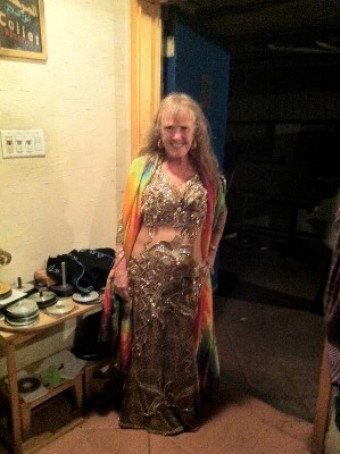
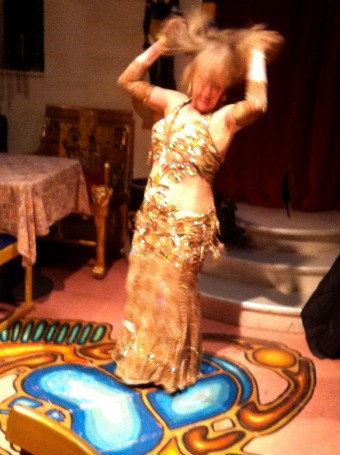
But back to Al Masri. Yes, Marsha had saved me a spot at her table,
but I got there before her. Linda was scheduled to dance and I
was really looking forward to seeing her in her new costume. She told
me that she was pretty excited too and that her costume reminded her of
my first one. Well, when I saw her in it, I realized why. It was an animal
print, as in leopard or cheetah, and I thought I was looking at mine except
she was in it. Yes, we could both wear our costumes to the Safeway
and feel totally comfortable in them while shopping for groceries. Yes,
we're neighbors and since we shop at the same store, maybe we could meet
up in our big cat costumes. Since coyotes and racoons like to hang around
that store, I doubt if anyone would even notice. Home
Contact us
